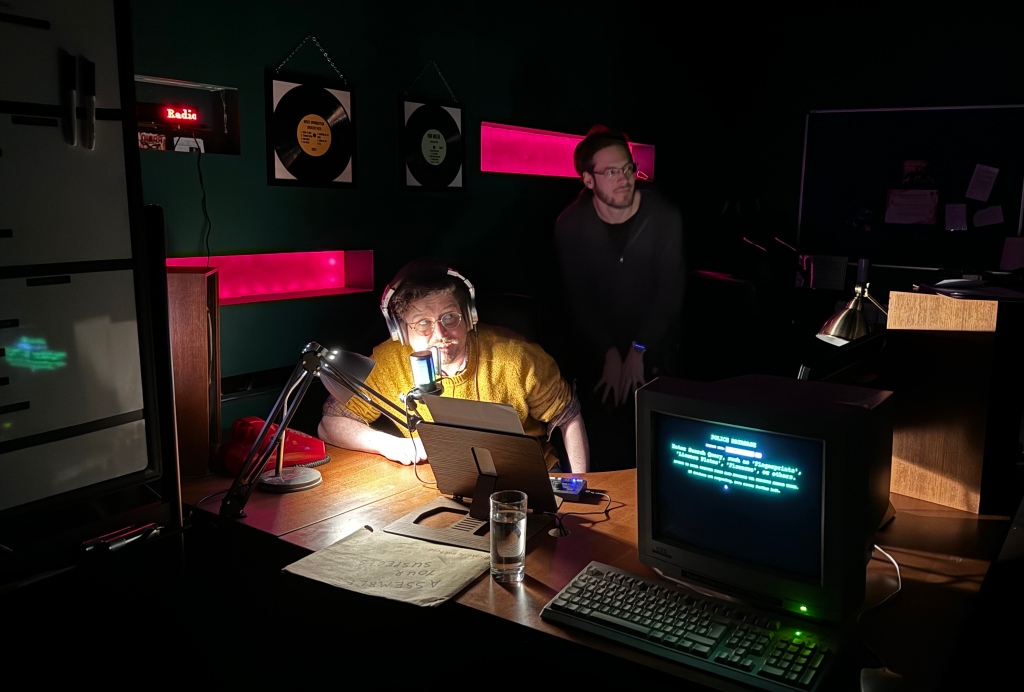Edinburgh, UK
£23-35/player (2-8 players)
Case Closed
90 minutes
Radio Nowhere is an escape room where you investigate a murder in a radio station. Players search the recording booth for clues hidden in notes, cassette tapes, databases, and mobile phones, while roleplaying as disc jockeys putting on 80s tunes and improvising news segments.
I was curious about Radio Nowhere for three reasons:
- It claimed to focus on “real deduction and mystery-solving skills, rather than standard puzzles” like the much-abused escape room tropes of combination locks and riddles. What would “real deduction” look like in an escape room?
- At 90 minutes, it’d be one of the longest escape rooms I’ve played. Would that feel boring or tiring?
- We’d need to act as radio hosts throughout the experience. Role play isn’t unheard of in escape rooms, but I hadn’t done it in such an extended or interactive fashion before.
I won’t leave you in suspense: I went in with two friends, Alex Macmillan and Matt Wieteska, and we were utterly charmed.
After a standard safety briefing, we were told something that was music to my gamification-hating ears: our completion time wouldn’t be tracked and there was no leaderboard. In fact, we should treat it more like a video game than an escape room.
Since there are many kinds of video games, I took that to mean we shouldn’t aim to solve puzzles as fast as we could but rather to luxuriate in the experience, as one might in a richly detailed detective game or immersive sim. The relaxed vibe extended to the puzzles. To prevent us becoming paralysed with indecision in figuring out murder suspects’ identity and motives, we were encouraged to submit our “puzzle sheets” early and often through a letterbox (more on that later), with no penalty for wrong answers.
And like immersive sims, we’d encounter optional parts of the story, but we shouldn’t feel a need to see or solve them all. They didn’t quite come out and say, “we’ll make sure you get to the end of the story on time” but that was the implication. Finally, while they suggested it’d be fun if we roleplayed as radio hosts and we might get some extra clues by growing our audience, that too was completely optional.
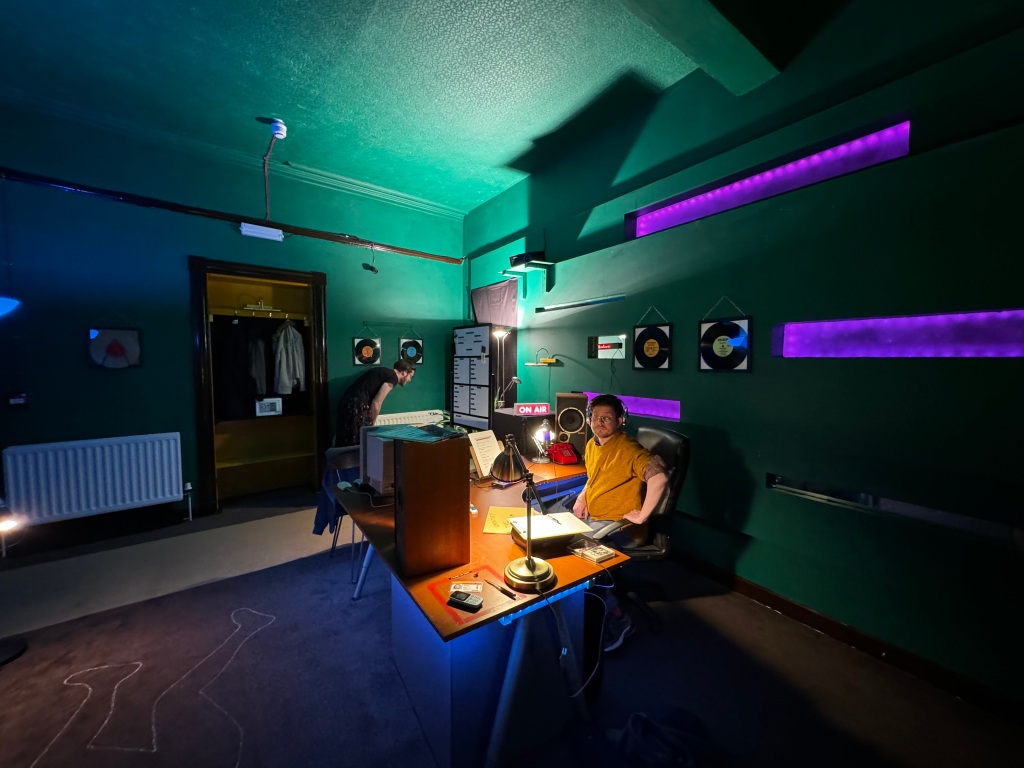
Once we entered the room, a non-diegetic voiceover played from the speakers, describing how we (the players) had arrived in the radio station to discover a murder had been committed, but understood that the show must go on while we conducted our investigation.
The voiceover was startlingly weird, like we’d walked into a noir movie. It would reappear a few times to update us on plot developments and new objectives, e.g. “the DJs discovered the identity of the killer, but now they needed to find where they’d hidden the goods.” A smart technique, if unexpected.
The first puzzle was more straightforward: identify the victim via items discovered on their person and clues in the environment (e.g. ID card, mobile phone, a torn jacket, etc.). We had a whiteboard to keep track of our theories:
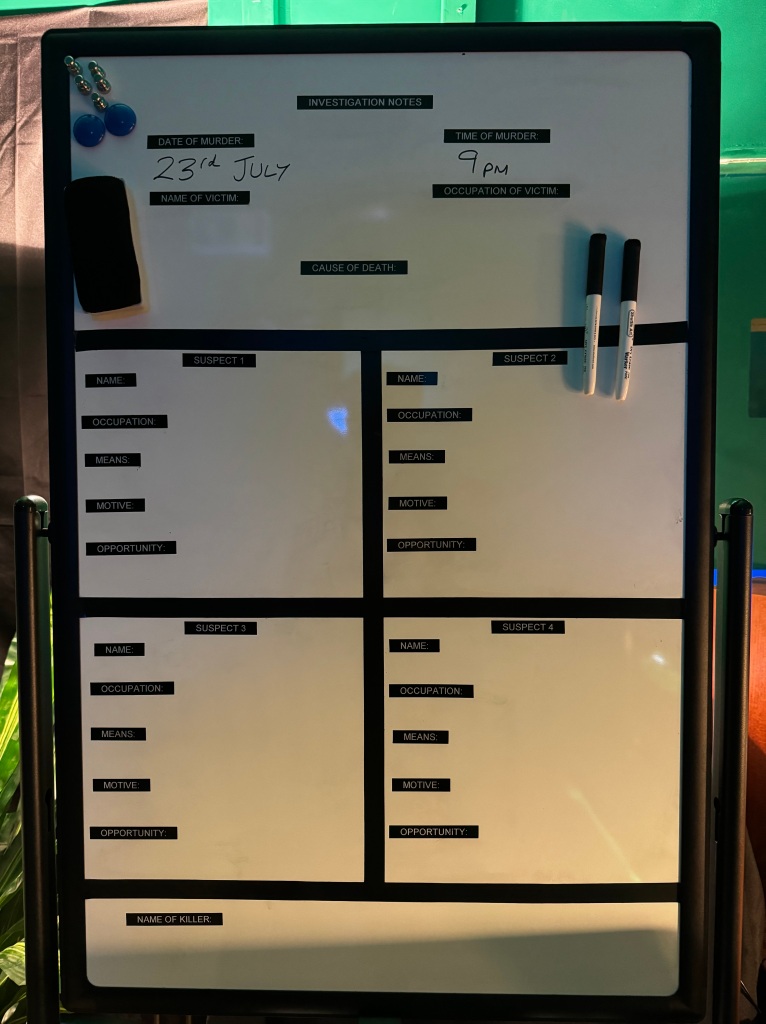
Once we’d discarded the red herrings, we wrote down our answers for the victim’s name, job, and cause of death on a laminated sheet with a dry erase marker, then posted it through a letterbox in the escape room’s main door. The fact that it wasn’t posted back to us indicated we were correct.
Next, we had to identify four suspects, along with their means, motive, and opportunity. This is where Radio Nowhere’s promised “real deduction” came in, because there was no simple list of radio station staff to consult. Instead, we had to piece together suspects’ identities from fragmentary information across flyers, computer records, scraps of paper, and cassette tape recordings of older radio broadcasts.
A typical line of thought was therefore, “The flyer says Alice is one of the two hosts, and the tape has Bella on as the night host, so she must be the daytime host; and the note we found says the car is only available during the day, so…” If this sounds familiar, it’s because you’ve played games like Return of the Obra Dinn and The Case of the Golden Idol, whose puzzles rely more on observation and deductive reasoning than “puzzle-ass puzzles” like code breaking and ciphers.
The wealth of information was almost overwhelming in the beginning, an occupational risk of making escape rooms that aim to mimic reality. A real recording booth would be littered with clues; it’d be silly if every desk drawer had separate combination locks. What’s really strange is how video games have trained players to accept limited access to the world with doors that magically unlock when you complete a level.
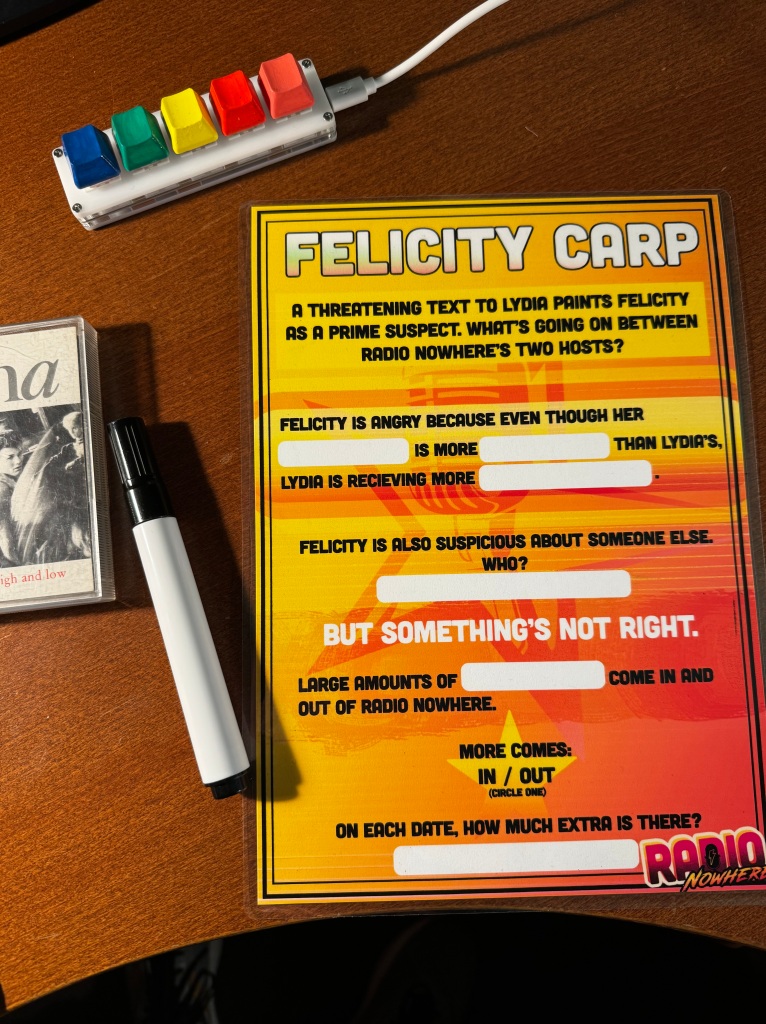
No doubt that’s why Radio Nowhere adopts so many ideas from video games. As soon as I saw the answer sheet with mad libs-like blanks in sentences, I knew the designers must’ve been inspired by The Case of the Golden Idol’s puzzle design, where players solve mysteries by dragging and dropping words into blanks.
The beauty of this system is how it guides and structures thinking. Instead of filling out a blank piece of paper with “What happened?” at the top, the blanks make it crystal clear which answers to look for and what level of detail to go into. You still have to investigate, but you don’t need to waste any time figuring out how the escape room designers want you to express your answer.
Another inspiration, confirmed afterwards by the designers, was Killer Frequency, a video game where you’re a radio host helping callers defend themselves against a serial killer. While the writing suffered from tonal inconsistency and the pacing was off, the period vibes were perfect and I enjoyed playing the host and swapping recordings and cassette tapes in VR.
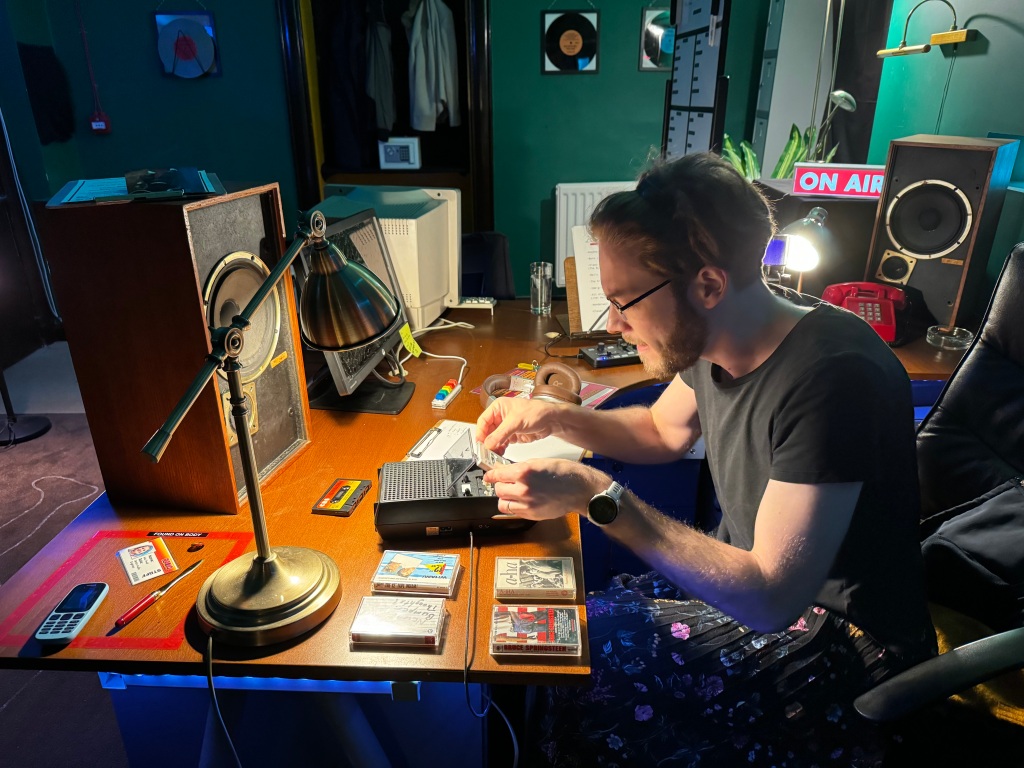
We didn’t spend anywhere near as much time playing DJs in Radio Nowhere, but they were some of the most fun moments. A projected instruction reminded us to play some music, which quickly revealed I’d forgotten how to load a cassette tape. Alex and Matt stepped in and we heard Bruce Springsteen’s dulcet tones via a real radio we had to tune in. Between songs, we took turns deploying every radio host cliche into the microphones, our listener count climbing into the six figures after minutes.
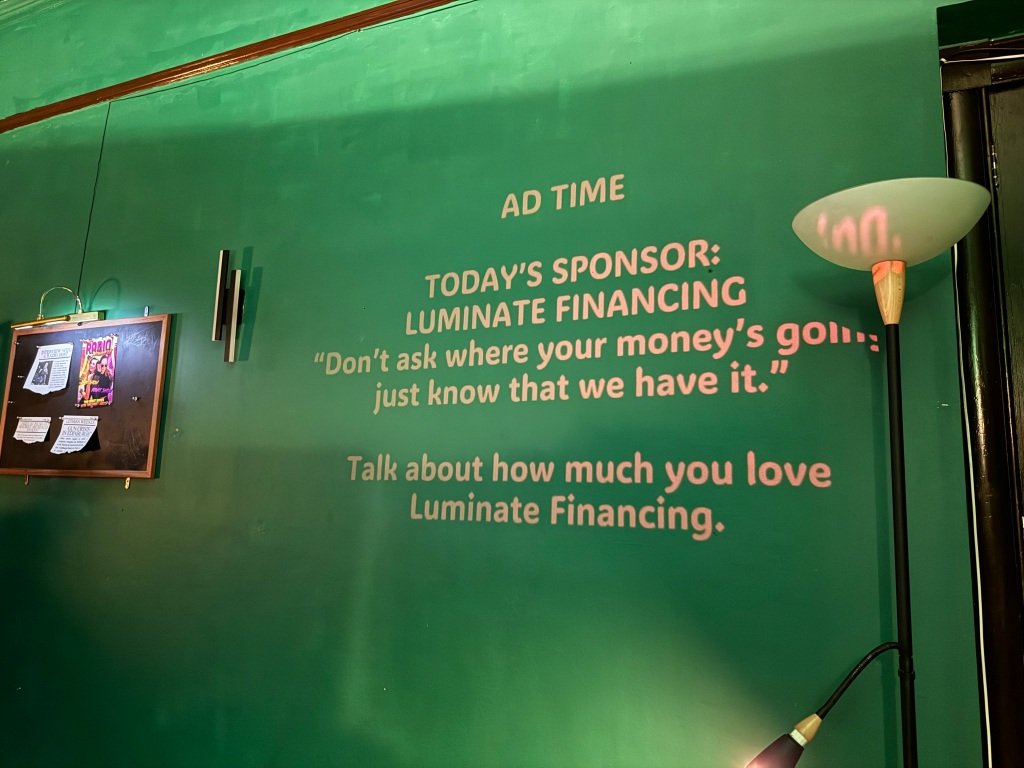
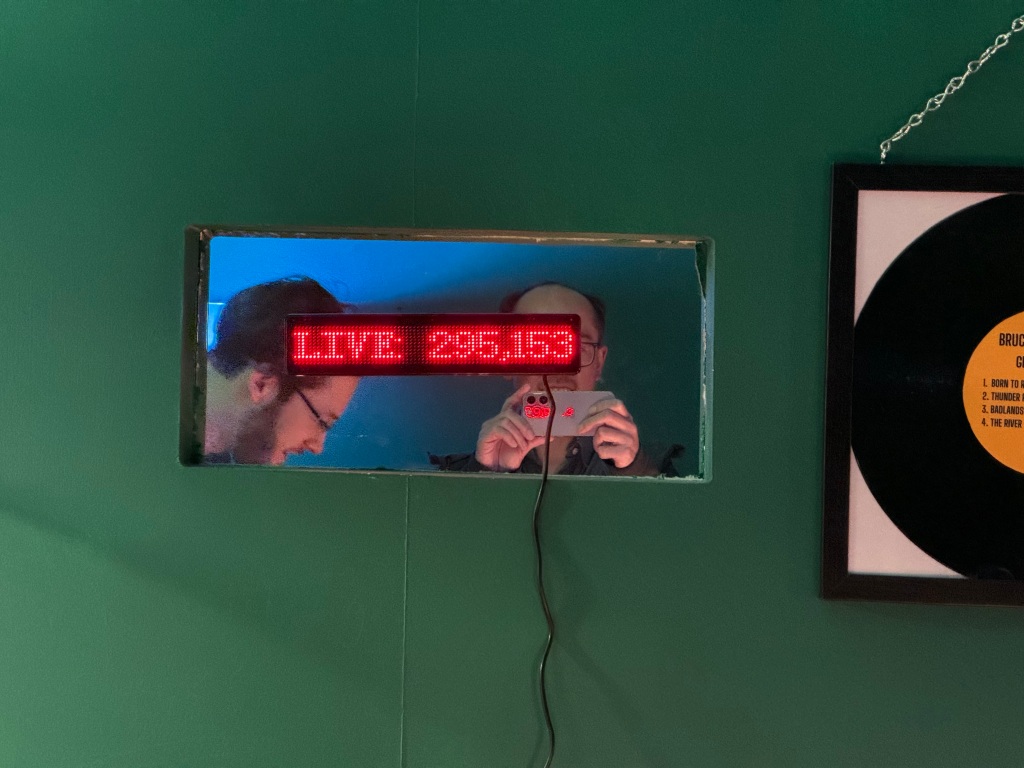
My new favourite book, Larp Design: Creating Role-play Experiences, discusses how to give players meaningful things to do. “It is usually boring to pretend to be doing things,” notes Kaisa Kangas, so it’s best to “make players do things for real, or to design simulation methods that give them an idea of how it feels to do those things.” A 2018 LARP about producing a reality TV series, Mr & Mrs Unscripted, saw some players actually film contestants with real camera equipment. Sometimes it isn’t possible to do things for real, like in Työhaastattelu, a 2004 LARP where players were hired to clean up an apartment after a murder:
The cleaning included sawing the body into small pieces and carrying it out in plastic bags. Obviously, the players could not do this to the person who was lying in a puddle of fake blood and pretending to be a corpse. To simulate the process, the designers had placed some logs in the apartment. The players sawed the logs and carried the pieces out in the bags to get a physical feeling of what the characters were doing.
Spoiler: we didn’t saw any logs during Radio Nowhere, but we really felt we were radio hosts. Alex improvised an ad read so well a caller praised their skill and dropped a clue. Matt conducted a one-man interview with himself on the epic Beverly Hillbillies YouTube video, during which Alex and I debated whether the audio from a record we’d found was a clue or not, and I presented the news based on headlines from clippings on the corkboard to solicit tips from listeners.
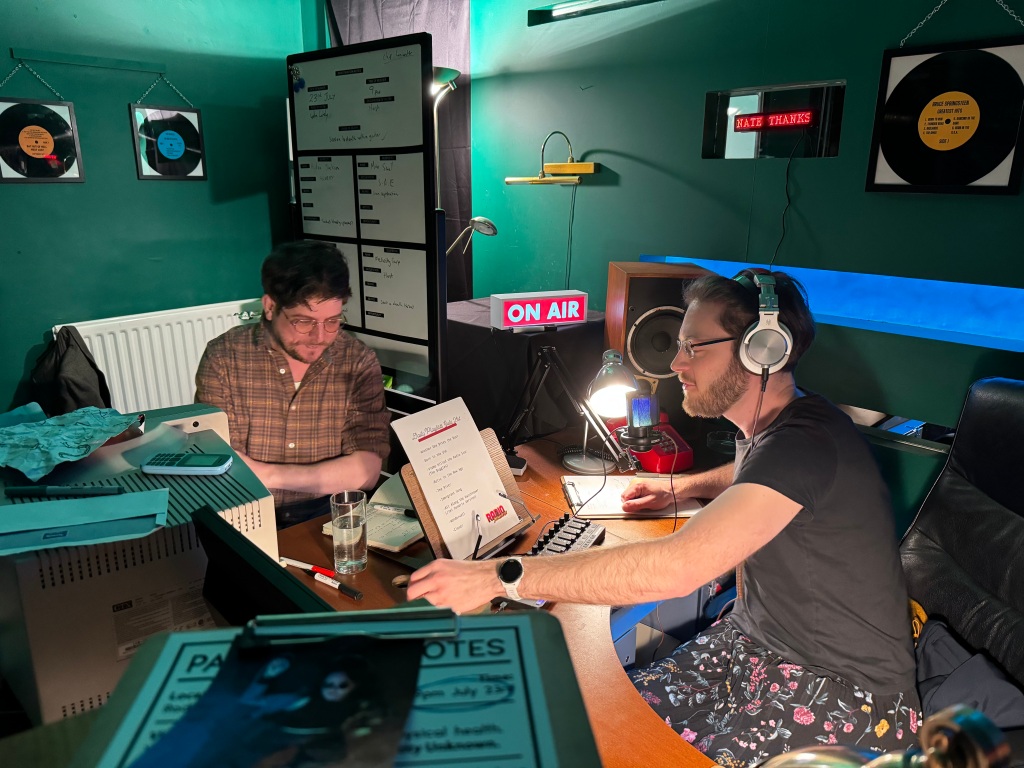
We couldn’t have spent more than fifteen minutes in total as hosts, and that was just one person at a time, but it gave us a breather between intense bouts of searching and solving efforts. Without these breaks, the 90 minute duration may have felt too much.
Around halfway through, we were instructed to pick two out of four suspects to investigate further. This was the anticipated “optional story” section to which there were no wrong answers, so we picked the two who seemed most guilty and received envelopes for both that unlocked various safes and lockers with more clues and leads. One memorable puzzle involved replying to an email on the computer, where I had to write in the style of a suspect; again, less of a puzzle and more like role play.

If we had moved faster, we’d have been given information about the remaining two suspects, but as it was, we were led into the final act where we tracked down the killer. I’ll skip over the ending to avoid spoilers, but the action escalated in a delightfully silly way that saw a mysterious colourful mini keyboard finally being put to use, and we finished right on the 90 minute mark.
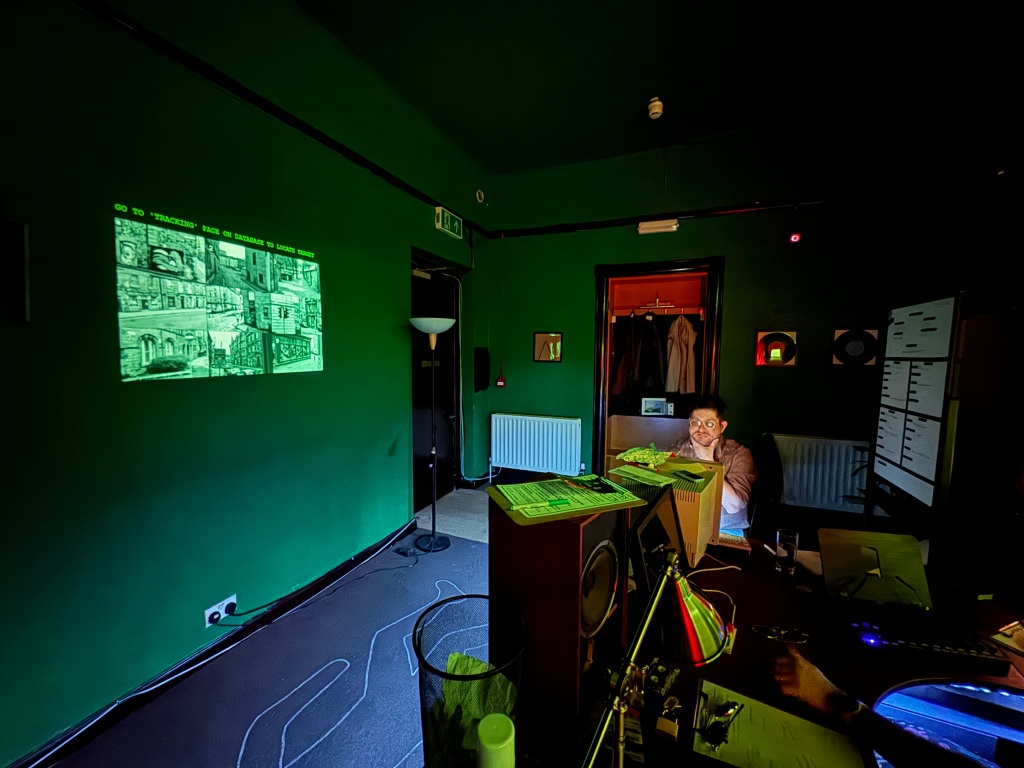
It turned out we were the only the eleventh group to play Radio Nowhere, which explains some of the teething problems we encounter with overly bassy audio and a recalcitrant cassette player. The room had some literal rough edges and felt a touch basic – one would expect acoustic foam tiles in a real recording booth – but it’s hard to criticise such an affordable experience.
The one thing that gave me pause isn’t unique to Radio Nowhere: the use of murder as motivation. It’s an easy way to raise the stakes, but it was tonally jarring to see death played for laughs here. Dark comedies can have high body counts, but the best, like Fargo, have a specificity to their characters and a willingness to be serious that elevates their story beyond mere punchlines. I’d love to see the designers either explore more non-violent scenarios or lean further into the violence, but at a different angle.
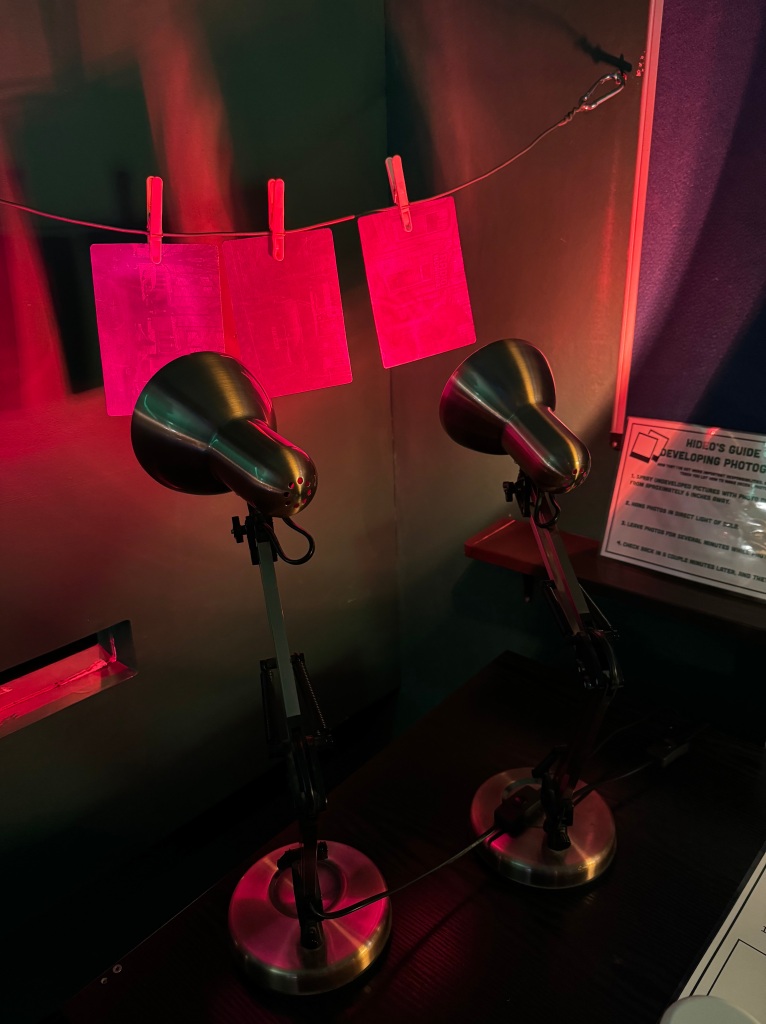
Combination lock-style puzzles, where you find a code in the pages of a book or on a wall in UV ink to unlock a compartment, have been derided amongst escape room enthusiasts for so long that I assume self-respecting designers stay well away nowadays. But my beef with them is not merely on the grounds they’re overused and predictable, but that they make little thematic sense – and neither do so many other escape room puzzles.
Anyone expecting total realism in a game where you’re solving a mystery in a locked room is bound to be disappointed, but there are points along the spectrum of what’s possible that feel worthy of exploration. Radio Nowhere sits much closer to the realistic end thanks to its theming, its genuinely deductive puzzles, and the space it gives players to role play. Those things are possible because it’s willing to push the artificiality of the experience with non-diegetic voiceovers and mad lib answer sheets.
The result may be less flashy, but it’s refreshing and surprisingly stress-free. A relaxing escape room – what a concept!
